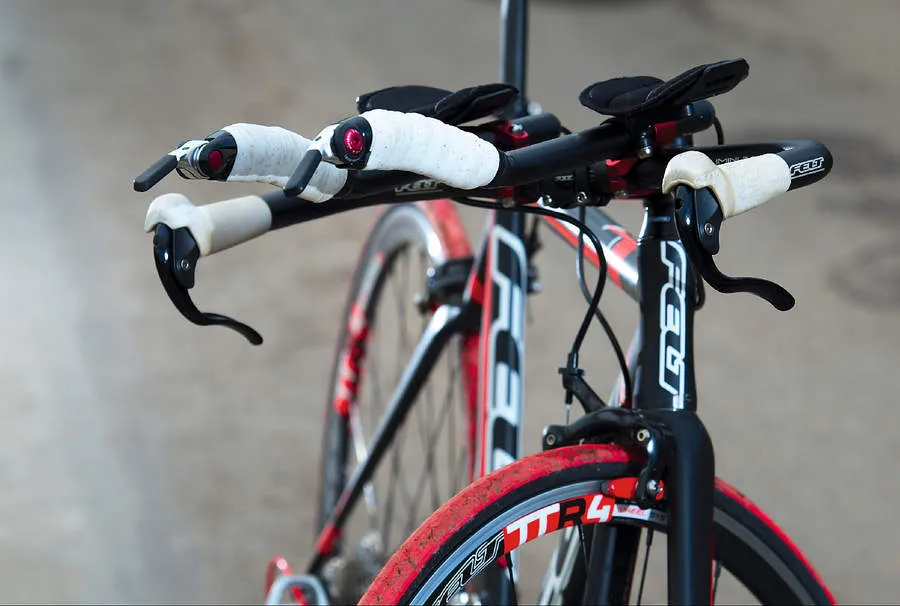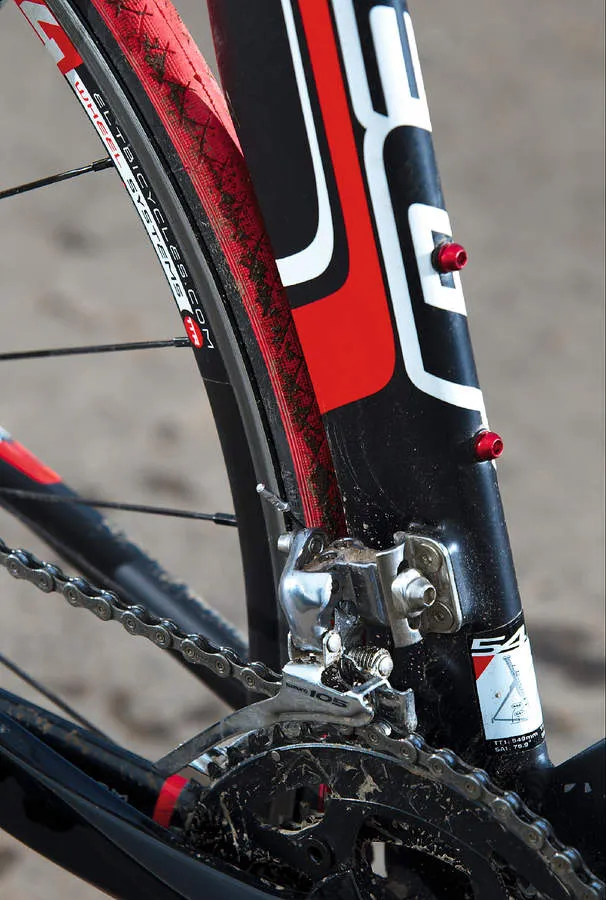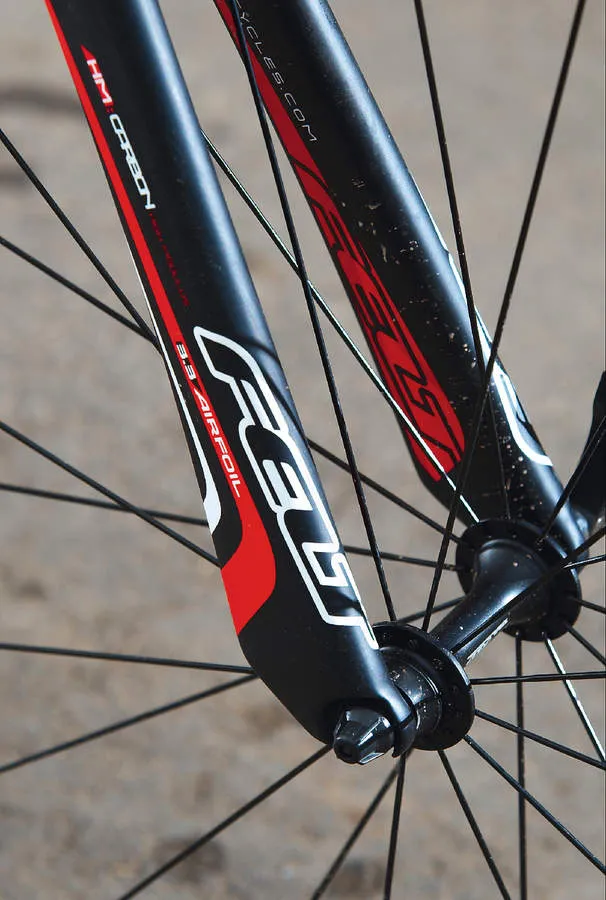Felt's S22 base model time trial bike shows they know how to make an outstandingly cultured ride without plundering your race-entry budget too deeply.
Ride & handling: Outstandingly smooth ride, but powerful riders may detect some flex
While its aesthetics may be eye-catching, it’s the subtlety of the ride from the S22 that really makes it stand out. Despite some steep-looking numbers on the geometry sheet, it feels balanced and controlled as soon as you clip in.
This assured surefootedness never falters, however fast you take it, and even on gusty days we rarely broke tuck, even on 50mph-plus descents. Clever frame tubing design, carbon seatstays, fork and seatpost, plus the ease with which you can get a really good fit makes it outstandingly smooth.
We’re prepared to forgive a bit of rattle on more price-conscious bikes, but there was nothing about the road feel of the S22 that wasn’t properly luxurious. It floated the bits that normally rattled our fillings, stayed settled into a rhythm through post-frost rut sections, and felt as though we had 20psi less pressure in the tyres than we actually did.
The compliance helps it feel surefooted and connected on rougher descents. While clarity isn’t as sharp as on some other aero bikes, cornering and descending speeds were often higher, though we’d have preferred stickier tyres than the Vittoria Zaffiros, to inspire more confidence. Secure hand position and broad brake levers meant we could brake harder and later too.
The S22's high degree of adjustability – a two-position saddle clamp plus long seat rails and adjustable length and width bar extensions – made it easy for us to find a position where we could comfortably put out the power. As we saw when we took it to the MIRA wind tunnel near Birmingham, that equated to extra speed.
We measured its 0° yaw CdA (coefficient of drag x frontal area) at 0.104, which went up to 0.109 at -5° and 0.112 at -10°. With a rider onboard, we measured 0° yaw CdA of 0.236 – the lowest of all the bike rider results in the test.
This frame was smaller than the others we tested, and the low standover height – and consequently low bar – and short head tube helped us tuck right down. But we didn’t feel cramped on it either – it was one of those bikes we immediately felt at home on.
The bike handled crosswinds as if they weren’t there. Again this was borne out by the wind tunnel tests, which showed the Felt had the greatest tendency to correct itself in a sidewind.
Inevitably at this price it’s not all positive, and there’s a slight lull in response caused by the heavier rotating weight of the wheels, and more give in the frame than on more expensive bikes. The 30mm section means they at least hold a spin well once you’ve got them going, though.
Some bikes do all their talking through the spec sheet, but to understand how good the S22 is you need to ride it. Outstandingly balanced and smooth base performance is backed up by accurate and adjustable fit details. The result is a luxury feel that outweighs any kit comparison or heavy wheel downsides for long-distance athletes.

Chassis: Lightweight, fine-boned frameset with a wide size range for a glove-like fit
The S22 is a good looking machine, with some attractive red anodising complementing its red, black and white colour scheme. It's mostly constructed from 7005 aluminium, but has a carbon rear end and carbon bladed fork to save a little weight.
The first thing that strikes you about the S22 is that everything about the frame is slender and finely boned. This starts right up front with a small 1in diameter head tube to minimise frontal area and leading edge drag. The slim teardrop down tube and small round section top tube tuck in behind it, with the latter swelling into a taller fin section where it meets the aero seat tube.
A low-set aero wishbone section syncs neatly into the rear of the seat tube, forking into two tapering carbon fibre seatstays to take out road sting. The joins between the aluminium seat tube and the carbon seatstays and chainstays are neatly done, hidden by a couple of well placed red stickers. Oval-to-round chainstays link up with horizontally slotted rear dropouts to let you tune tyre clearance against the wheel-hugger cutout, although it does slow down wheel removal.
While it’s theoretically not as aero, external gear cable routing – complete with barrel adjusters to tune indexing – is a lot easier to work with, and the straight-through brake cable routing is clean and easy too. The Felt makes use of Jagwire cables.
Geometry-wise there was nothing out of the ordinary, with our 54cm model featuring a 76.5-degree seat angle and 72.5-degree head angle. Frameset weight is good for the price (2,046g/4.5lb), meaning this chassis has plenty of upgrade potential in reserve.
The 3.3 Airfoil forks have carbon fibre legs in a subtle batwing shape, and the aero seatpost is carbon-shafted too. Two saddle positions on the top clamp give the potential to change the effective seat tube angle by two degrees. Two 650c wheel frame sizes as well as five conventional 700c wheel-size options give a very fine-fitting spread as well.

Equipment: Heavy wheels and average kit eat into acceleration and overall agility
Felt’s componentry choices underline the fact that getting you feeling right on the bike is a priority. Not only does supplied crank length, stem length and base-bar width change depending on what frame size you pick, but the alloy Felt extension bars are super-adjustable.
As well as reach and rotation adjustment, they also have bags of sideways and fore and aft adjustment, and you can switch the whole clamp to sit underneath the base bar. The removable cone on top of the headset bearings lets you get even lower as you get used to the position too.
The extensions come not with Shimano but with MicroShift bar end shifters. We suspect this is because of the red anodising on the lever pivots. They also give softer changes than Shimano levers. The base bar comes with Devox Tritip ergonomic grips, which we found had a tendency to swivel around a bit. We’d advise you to stick with white bar tape, as used on the extensions.
The Felt saddle has a soft, wide gel nose and extended rails for greater fore-aft adjustment, and is particularly comfy in a deep tuck, while the Zipp-style rubber grip hoods and broad brake levers inspire confidence. The mechanical aspect isn’t as inspiring as the contact point detailing, though. The house-brand wheels are basic, heavy 30mm-deep-rim aluminium models. They’re stiff enough to train and race on, and they handle well in crosswinds.
We wonder whether the Vittoria Zaffiro clincher tyres were chosen because they’re red rather than because of their performance, but whatever the reason, we’d prefer Vredestein Fortezza Tricomps – and they’re available in red too.
The Shimano 105-based gearing with 550 crank – 53/39 chainset, 12-25 cassette – is just okay for the money, rather than outstanding. The black version of 105 looks a little cheap but it does match the rest of the S22’s colour scheme well, even down to the red brake shoes.
Finishing trim such as red anodised cable ends, bar clamps and outer faces on the non-Shimano shifters plus red rear cable-loop and red painted cartridge brake blocks all increase shop floor and ‘show and tell’ appeal.




